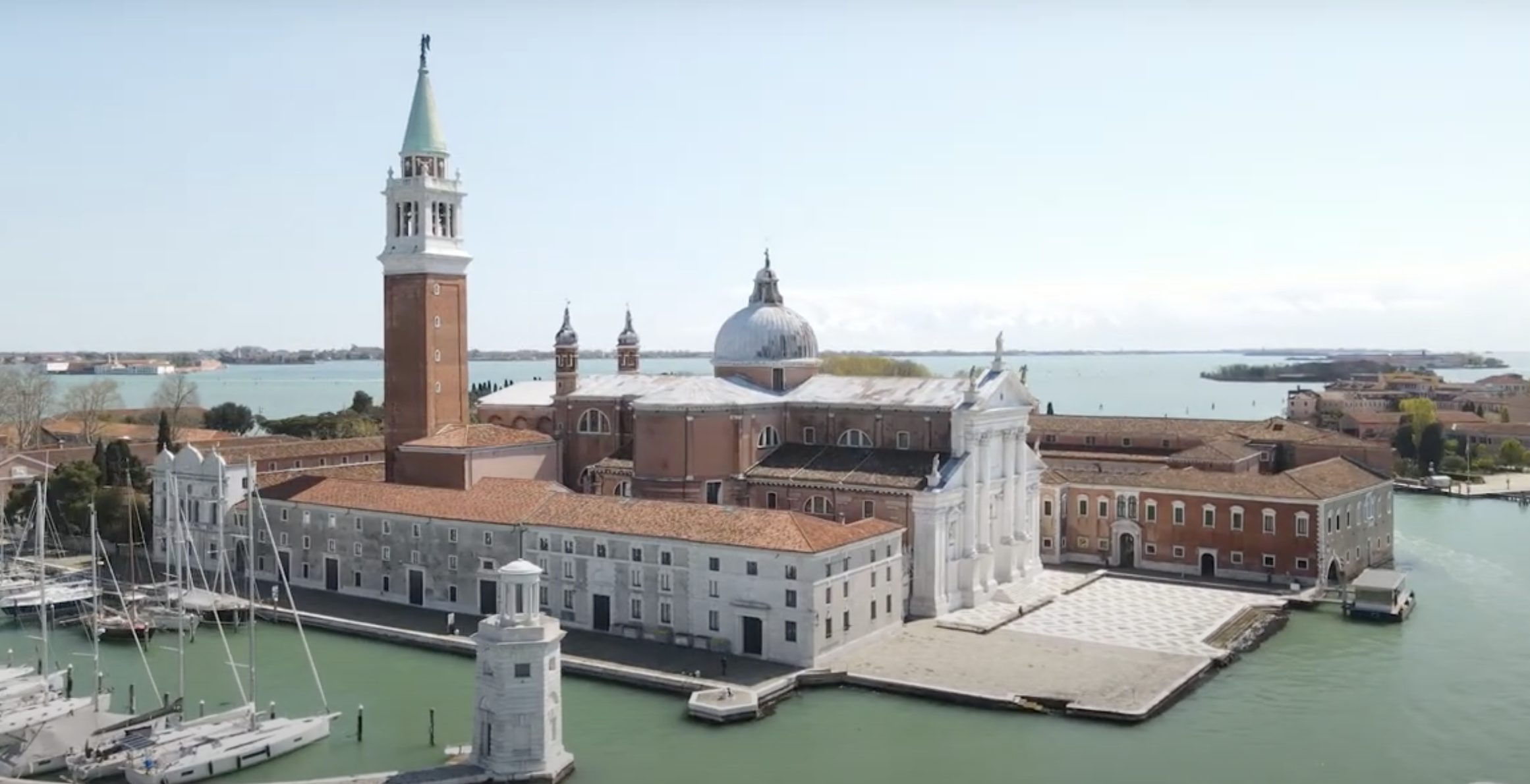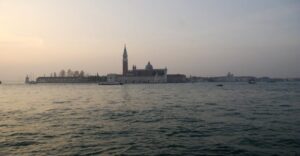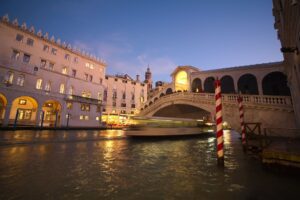San Giorgio Maggiore — Venice’s Island of Light and Silence
Stand on the Riva degli Schiavoni at sunset, and your eyes are inevitably drawn across the glittering lagoon to a vision of white marble and perfect proportion. Rising from the water like a dream, the Basilica of San Giorgio Maggiore has been painted by Canaletto, Turner, Monet, and thousands of modern visitors who couldn’t resist lifting their cameras. It is one of those rare views that defines Venice itself — timeless, balanced, and bathed in light.
Yet few people ever cross the canal to set foot on the island. Those who do discover one of Venice’s most astonishing worlds: a place of Palladian architecture and Tintoretto’s masterpieces, of Benedictine silence and contemporary art, of labyrinths, concerts, and gardens that still whisper of monastic life. San Giorgio Maggiore isn’t just a postcard — it’s the beating cultural and spiritual heart of the lagoon.
🌊 1. Where Is San Giorgio Maggiore?
The island lies directly opposite Piazza San Marco, across the broad Bacino di San Marco. Its location is theatrical: to the north, the Doge’s Palace glitters; to the east, the Lido marks the lagoon’s mouth; to the west, the Giudecca Canal and island stretch away toward the sunset.
From the bell tower of San Giorgio, Venice unfolds like a stage set — domes, towers, and canals suspended between sky and sea. It is the same view that inspired Guardi’s romantic brushstrokes and Turner’s vaporous light. No matter how many times you’ve seen Venice, this perspective makes you fall in love all over again.
📜 2. The Origins of the Island
Like much of Venice, San Giorgio began as little more than a sandbank. By the tenth century, it was home to a small settlement and a chapel dedicated to Saint George — the soldier-saint who slayed dragons and embodied courage. In 982, Doge Tribuno Memmo donated the island to the Benedictine Order. What began as a humble hermitage soon became a center of prayer, agriculture, and learning. The monks drained marshes, planted orchards, and turned their island into a spiritual and intellectual oasis.
For nearly a millennium, the Benedictines of San Giorgio balanced manual labor with scholarship. Their motto, ora et labora — pray and work — still defines the island’s rhythm today.
🏛️ 3. Palladio and the Basilica of San Giorgio Maggiore
In 1566, the Benedictines commissioned Andrea Palladio — the genius of Renaissance proportion — to rebuild their church. The result became one of architecture’s purest expressions of harmony.
The Façade
- Constructed of gleaming white Istrian marble that glows in the lagoon light.
- Combines two overlapping temple fronts — one tall and one wide — to unite classical ideals with Christian symbolism.
- So perfectly measured that Palladio’s design textbooks still use it as an example of divine proportion.
Seen from across the water, the façade appears almost weightless, a vision of serenity floating on the tide. Every sunrise re-paints it in gold; every storm turns it silver.
The Interior
Inside, the church opens like a breath of air — vast, luminous, geometrically precise. Palladio orchestrated light and space like a symphony. Between columns and arches hang masterpieces by Tintoretto, including his Last Supper (1592–94), a daring diagonal composition where Christ’s halo seems to glow in candlelight. Nearby, his Gathering of the Manna fills the side chapel with motion and mystery. The high altar, designed by Girolamo Campagna, completes the sense of balance between matter and spirit.
The Bell Tower (Campanile)
Rebuilt in 1791 after the original collapsed, the campanile rises like a slender sentinel over the lagoon. The elevator ride to its summit is quiet and quick, and the panorama — unlike the crowded San Marco tower — is almost always peaceful. From here, you can see the entire geography of Venice: the Grand Canal curling like a ribbon, the domes of Salute, the Lido’s green line, and the infinite shimmer of the Adriatic beyond.
📚 4. The Benedictine Monastery — A City Within an Island
Behind the basilica lies a hidden world of cloisters, corridors, and gardens. Designed by Palladio’s disciple Vincenzo Scamozzi, the monastery remains one of the finest examples of late Renaissance monastic architecture.
- The Cloisters of the Monks — perfectly proportioned courtyards where sunlight filters through arcades.
- The Refectory — once home to Veronese’s Wedding at Cana, stolen by Napoleon in 1797 and now in the Louvre; a full-scale replica restores the balance of Palladio’s space.
- The Library and Archives — housing centuries of manuscripts, maps, and illuminated codices — a treasure for scholars worldwide.
For centuries, this was Venice’s intellectual heart, where theology, art, and science met over candlelight and parchment.
🏛️ 5. The Giorgio Cini Foundation — A Modern Renaissance
After the fall of the Republic, San Giorgio declined. By the early 1900s, its monastery was crumbling. Salvation came from Count Vittorio Cini, one of Italy’s great industrialists and philanthropists. In 1951, after the tragic death of his son Giorgio, he founded the Giorgio Cini Foundation to restore the island and transform it into a cultural beacon.
Today, the Foundation hosts world-class exhibitions, conferences, and concerts, preserves invaluable archives, and fosters academic research. It is, in every sense, a continuation of the Benedictine spirit — devoted to knowledge and creation rather than prayer alone.
With Tour Leader Venice, visitors can access guided visits that reveal the Foundation’s art collections, hidden cloisters, and serene gardens — a rare privilege usually reserved for scholars.
🌿 6. The Borges Labyrinth — A Walk Through Infinity
Among the island’s more poetic surprises is the Borges Labyrinth, inaugurated in 2011 and dedicated to the Argentine writer Jorge Luis Borges. Designed by British architect Randoll Coate, it consists of 3,200 boxwood plants forming a path of 1.1 kilometers — a living metaphor for time, mirrors, and choice.
Walking the maze feels like entering one of Borges’ stories — each turn suggests an alternate world, each reflection a philosophical question. From above, the pattern spells the author’s name. It is both playful and profound — a meditation disguised as a garden.
The labyrinth can be visited via guided tours organized through the San Giorgio Maggiore group tour — a serene experience away from the city’s noise.
🎨 7. Art and the Venice Biennale
San Giorgio’s vast halls and cloisters regularly host exhibitions connected to the Venice Biennale. Artists find in its silence the perfect counterpoint to the bustle of the Giardini and Arsenale. You might wander into an installation of glass and light, a sculpture garden framed by cypress trees, or a photography show exploring Venice’s reflections.
During Biennale seasons, the island becomes a creative sanctuary where past and present converse — Tintoretto’s canvases sharing space with video art, Palladio’s geometry dialoguing with contemporary abstraction.
🎵 8. Music and Performance — Echoes Across the Water
Music has always been part of San Giorgio’s identity. The Squero Auditorium, a modern concert hall with windows opening directly onto the lagoon, hosts chamber-music evenings where the sound of strings blends with lapping water. Within the basilica, choirs and organ recitals fill Palladio’s nave with celestial resonance. The Cini Foundation’s cultural festivals continue Venice’s tradition of uniting art, faith, and beauty — as natural here as tide and stone.
🌺 9. Gardens and Open Spaces
Unlike much of central Venice, San Giorgio breathes. Its orchards, lawns, and boxwood labyrinths recall the Benedictine ethos of harmony between nature and spirit. From the garden paths, you glimpse gondolas sliding silently across the water, hear church bells echoing from San Marco, and feel the island’s rare tranquility. It is a haven of green amid marble and salt.
🌅 10. San Giorgio Today — A Living Island
San Giorgio Maggiore today is many things at once:
- 🕍 A place of worship — the Basilica still hosts services and choral events.
- 🎓 A study center — the Cini Foundation houses institutions for music, theater, and heritage research.
- 🖼️ A cultural hub — its cloisters and gardens welcome exhibitions and Biennale projects.
- 🌿 A retreat — green lawns and open views make it a place of pause after Venice’s crowds.
Despite its proximity to St. Mark’s, the island remains uncrowded. Many visitors still only admire it from afar — which makes crossing over feel like stepping into a secret chapter of the city’s soul.
🚤 11. How to Visit San Giorgio Maggiore
- Vaporetto: Line 2 stops at San Giorgio, just three minutes from San Zaccaria (by St. Mark’s Square).
- Opening Hours: The basilica is open daily; the campanile and labyrinth have separate ticket booths.
- Tickets: Church entry is free; small fees apply for the bell tower and labyrinth — book skip-the-line tickets online.
- Best Time to Visit: Morning for golden light inside the basilica; sunset for unrivaled panoramas.
- Combine With: A private lagoon itinerary including Giudecca, Murano, or Torcello with Tour Leader Venice.
✨ 12. Why You Shouldn’t Miss San Giorgio
- The View: Unquestionably the best in Venice — a 360-degree sweep from the Doge’s Palace to the Adriatic.
- The Art: Tintoretto’s masterpieces, Palladio’s geometry, Veronese’s echo on the walls.
- The Atmosphere: Serene, spiritual, and deeply moving — a counterpoint to the city’s energy.
- The Culture: From the Cini Foundation to the Borges Labyrinth, art and thought continue to bloom here.
- The Perspective: Across the water, Venice looks like a painting come to life — and you are standing inside its frame.
🕊️ 13. Conclusion — An Island of Timeless Balance
San Giorgio Maggiore is not just a pretty façade on Venice’s horizon — it is the city’s mirror, reflecting what Venice has always been: a place where faith, art, and beauty intertwine. From Palladio’s columns to Tintoretto’s brushstrokes, from the Benedictine gardens to the Cini Foundation’s concerts, this island embodies centuries of Venetian grace and renewal.
When you stand on its terrace and watch the light fall over the city, you understand why so many have called Venice a miracle. It isn’t just built on water — it’s built on balance, between past and present, earth and heaven.
👉 Book your private San Giorgio Maggiore experience with Tour Leader Venice and discover the island where architecture, art, and silence create Venice’s most perfect harmony.
❓ FAQs — San Giorgio Maggiore, Venice’s Island of Light
Can you visit San Giorgio Maggiore in Venice?
Can you visit San Giorgio Maggiore in Venice?
Yes. San Giorgio Maggiore is open to visitors and easy to reach — simply take Vaporetto Line 2 from San Zaccaria (next to St. Mark’s Square); it’s just a three-minute ride. You can explore the Basilica, climb the bell tower for the city’s best panoramic view, and visit the Borges Labyrinth or exhibitions organized by the Giorgio Cini Foundation.
What can you see on San Giorgio Maggiore Island?
The island is a masterpiece of art, architecture, and silence. Highlights include Palladio’s Basilica, Tintoretto’s Last Supper, the Benedictine monastery cloisters, and the Cini Foundation’s gardens. Don’t miss the Squero Auditorium for chamber-music concerts and the Borges Labyrinth, a living sculpture dedicated to the Argentine writer.
Can I visit San Giorgio Maggiore with a private tour?
Absolutely. Tour Leader Venice offers exclusive experiences combining the Basilica, Cini Foundation, and Borges Labyrinth with a private boat ride across the lagoon. You can even extend your itinerary to include nearby islands such as San Servolo, San Lazzaro degli Armeni, and Isola della Certosa — or end the day in style with our Venice Sunset Tour on a Traditional Bragozzo Boat, the most enchanting way to see San Giorgio bathed in evening light.







